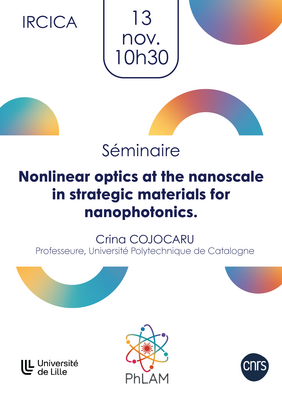Séminaire du laboratoire PhLAM par Crina COJOCARU
phlam Séminaire Vie du laboLe séminaire sera animé par Crina COJOCARU, Professeure à l'Université Polytechnique de Catalogne (Espagne), et aura pour thématique "Nonlinear optics at the nanoscale in strategic materials for nanophotonics".
Résumé :
The use of semiconductors and metals in the process of fabrication of actual nano-devices exploits the properties of light propagation and localization at the nanometer scale in new and surprising ways, with a miriad of possible applications.
At the nanoscale, light-matter interactions display physical phenomena that may not be completelly explained by conventional approximations, and then should be either revised or voided. Typical nonlinear processes, like second and third harmonic generation, have been traditional studied in thick and transparent nonlinear materials and under the phase-matching condition which assure a high efficiency of the process. At the nanoscale and under ultrashort and intense pulsed illumination, phase matching condition plays no role, light can propagate and resonate even in spectral ranges that are usually opaque, and surface nonlinear effects may be as efficient as the bulk components. The effective second and third orded nonlinear susceptibilities may not coincide with their bulk, local counterparts and may depend on pump depletion, pulse duration and on the type of nonlinearities that are triggered, and their associated linear and nonlinear dispersions.
A detailed analysis and understanding of harmonic generation matching the experimental and theoretical points of view is needed and would be very useful to further integrate these materials in the design of nanometric devices.
I will present a collection of experimental results of nonlinear harmonic generation at nanoscale in metals and semiconductors. The comparison of these experimental results with numerical predictions of our theoretical model identifies, distinguishes and explains the different nonlinear contributions to the harmonics generated by these materials at the nanoscale. Our model accounts for surface, magnetic and bulk nonlinearities arising from free and bound charges, preserving linear and nonlinear dispersion an nonlocal effects.
At the end of my talk I will shortly present the Erasmus Mundus Master “Europhotonics”, jointly thought by the Université Aix-Marseille, Karlsruhe Instityte of Technology (KIT), Germany, Universitat Politècnica de Catalonia, Barcelona, Spain, Tampere University, Finland and Vilnius University, Lithuania.
Le résumé est disponible ici.

